Art of the Genre: The Halflings of Jeff Dee
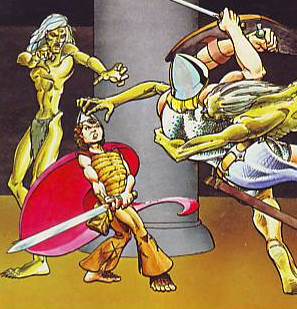
I was playing Keep on the Borderlands this past week, certainly one of my all-time favorite modules, and as I flipped through it I came across a Jeff Dee illustration that had a Halfling in the background. As two weeks ago I’d done a piece here on BG called ‘The Top 40 RPG Artists of the Past 40 Years’ AND had left Jeff off that list, I couldn’t help but stare at the image and wonder why I had done so.
Certainly people in the OSR had raised a big fuss about Jeff’s lack of ‘love’ on my part, and for good reason. He could have arguably made the list, depending on how you viewed the industry as a whole. Add such a view to the fact that Jeff has been a tireless game designer, player, and advocate for the industry of RPGs since I was in grade school, then he could almost be grandfathered in just for trying so hard. I guess it would be like a Lifetime Achievement Oscar or something.
Whatever the case, I sat there looking at this great little Halfling and couldn’t shake the feeling that of all the artists to ever do these little guys, Jeff was hands-down the best in my opinion, and here are the reasons why.
One: Jeff is a gamer, and as such, he has an inherent connection to how gamers see themselves, and with that, how gamers see their characters. Certainly, the thought of a Halfling is appealing because of Tolkien, but not necessarily the thought of Bilbo Baggins. Sure, we all love Bilbo, but do we love the Rankin/Bass version as a representation of our player characters? I doubt it.
Two: Jeff drew from a comic book style and therefore his lean lines for humans and elves spilled over directly to Halflings. Gone were the pot-bellied and cheery pipe-smokers, who were in turn replaced by ‘little men’ with ripped chests, chiseled faces, and weapons and armor that looked incredibly formidable.
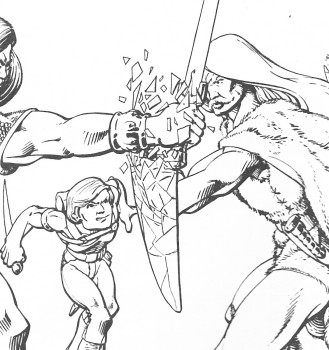
Three: Jeff liked to show Halflings in actions other than picking pockets or running scared. His Halflings were fighters first and thieves second, more inspired by the rules of Basic D&D than Advanced, and therefore came off as a more valuable addition to a party.
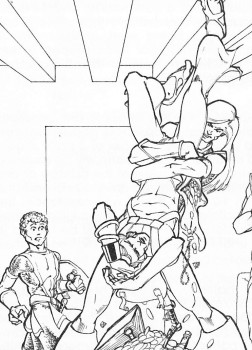
Four: Jeff Dee’s style is simply cool, period. He did the absolute best orcs ever created for D&D in my mind, so why wouldn’t his Halflings also be the best as well?
So there you have the basics, and why I started to pull down every adventure and supplement I could find from 1979 to 1981 for D&D. You would be very surprised at what you can discover when you go digging, and once again just how much art Jeff did. I was talking with artist David Martin recently and he said that a cover artist would get a month to do a single cover, while an interior illustrator could get sixteen illustrations done in that time, or more. Dee, like Jim Holloway, could not only churn out the occasional color cover, but the bulk of his day was spent using ink, and that meant his overall contribution numbers were far greater during his time at TSR than say Elmore, Parkinson, or Caldwell.
Now sure, ‘bulk’ deals can often be a bad thing, but in this case, we aren’t looking at Sam’s Club type art. Jeff managed to do fantastic line art at speeds that kept TSR’s production schedule on pace for the next large boom in the industry. Unfortunately for Jeff, he did get to ride that wave, but no matter the reasons behind that it doesn’t diminish what he accomplished in those three years at TSR.
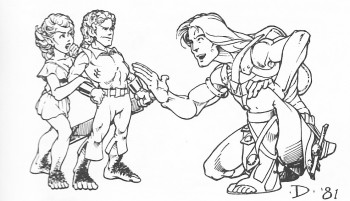
I mean, he was a kid then, just eighteen and full of piss and vinegar that I’m not really sure has left him to this day, but his artwork sang with it. Everything about his work championed the immortality of youth, an inexhaustible strength in his pen, the drive of the chronologically favored, and his Halflings practically dripped with it.
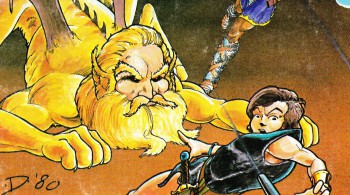
As I looked over one after the other, I couldn’t help but smile and wish that I had more adventures in me, more days in the sun where I could play a Halfling with some purpose and joy. It was an odd feeling actually, because the more I thought about it, the more I realized I never really have played Halflings, and my age is probably the reason.
When I started playing D&D, I got the Red Box and the Elmore/Easley version of a Halfling, which much like the Tolkien version, was unappealing as a gamer. Had I been raised on Dee’s vision, then I’m sure there would have been more than a few of these little buggers in my old file cabinets, but alas that was not the case. So, I’m now stuck with this incredible and inspirational artwork and no time left to do anything about it, unless I make a Halfling for my next ‘The Week’ in March. Hmmm, that is something to think about. I wonder if Jeff is currently available for a commission?
If you like what you read in Art of the Genre, you can listen to me talk about publishing and my current venture with great artists of the fantasy field or even come say hello on Facebook here. And my current RPG Art Blog can be found here.
Thanks for revisiting some of these fine illustrations — I’m surprised at how potently they brought back fond memories.
That one of the guy getting a shakedown in splendidly pulled off — such kinetic energy caught in the moment, you can just see his legs kicking and flailing in the air!
S2! White Plume Mountain! I remember that!
Nick: No problem, it was a great trip down memory lane! ‘Shakedown’ is an outstanding image for sure!
Joe H: Yeah, the manticore of S2 is a rocking cover. I didn’t have space for a great Slave Lords Halfling either, which is another great cover, but oh well 🙁
DEE RULES.
That is all.
I know a lot of people point to Elmore as the Platonic Form of D&D artist. But I’ve always thought that honor should go to Jeff Dee instead. I think his style of fantasy art was crisp and exciting. His fantasy characters and monsters looked sort of retro 70s-ish.
Interestingly enough, I don’t think Dee’s current work is as interesting. His lines are more sloppy or something. I don’t know. It just doesn’t seem to match up with his early and mid-80s classic stuff.
Perhaps oddly, the first piece of art that comes to my mind when I think of Dee is the cover he did for the TSR mini-game “Revolt on Antares.” I’d have to dig out my old copy, if I could even find it, but I think he did a good bit of the interior artwork as well.
John F: Oh no you didn’t just drop the microphone and walk off my stage again! 😉
James: I must agree on various counts.
Ty: Some of Jeff’s best work was from Revolt. I have the game close at hand on my desk shelf and if ANYTHING from old TSR had survived, I would have loved it to be this art because there is A LOT of it in that game. Also, it is so small in reproduction that seeing the real size originals would be fantastic. I review the game at my Art of the Genre site here: http://artofthegenre.com/blogs/news/8056499-nothing-revolting-about-revolt-on-antares
I was always fond of playing Halflings and it is largely due and inspired by the Jeff Dee images. He truly did create a more epic looking halfling character, but of course all his images are epic!
Somewhat tangentially, on the question of whether a halfling character can be a bad-ass: in 3.5 edition, sneak-attack rules make higher-level halfling rogues into mini assassins. A rogue sneak attack can inflict similar damage to the magical battle-axe of your half-orc barbarian — in a rage. (And certain magic items available in expansion compendiums extend sneak attack to elemental and undead creatures — Booyah!)
Around the table, our party refers to our 12th-level halfling Beeble as the “stealth nuclear bomb.”